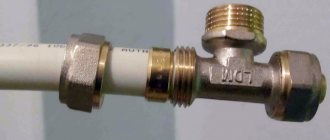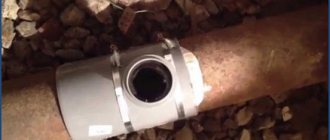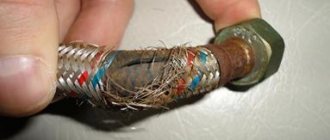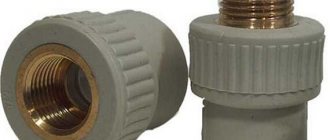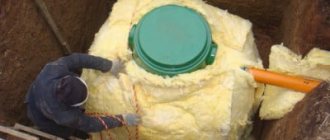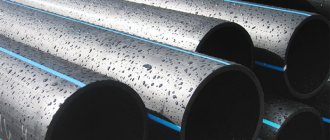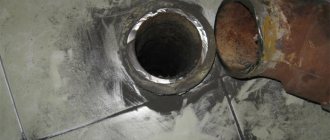Replacing a water supply or sewer system is considered a domestic disaster for many owners, and not everyone can cope with such a task due to the complexity of the process itself, as well as ignorance of the technology and methods of proper installation of pipelines. Regardless of whether the reason for repairs and replacements is leaking pipes or plans to modernize a bathroom, kitchen or entire apartment, the work must be carried out in compliance with technology and standards. Since cast iron sewerage is no longer in active use, you will need to switch to plastic. This is exactly what our material is dedicated to.
When should sewer pipes be replaced?
As a rule, in houses that have been in operation for more than twenty years, cast iron sewer pipes are installed, or a combined option is used: a cast iron riser and plastic outlets for the bathtub and kitchen. What you need to know about cast iron? This metal is susceptible to corrosion. Couplings (elbows, tees, etc.) quite quickly become overgrown with a layer of dirt and corrode faster, straight sections less so, but still, during major repairs or in the event of an accident, cast iron sewer pipes should be replaced if possible.
Old sewer pipes, especially cast iron ones, are often highly susceptible to corrosion and leaks are not uncommon. You should also examine the condition of the riser. Replacing the sewer system in an apartment cannot always ensure the guaranteed quality of the entire system in the house, and you have to think about replacing the house riser. However, if the sewer system is relatively new and made of plastic pipes, then there is no need to replace the risers. Perhaps laying a different route to the place of waste collection, or changing their location, perhaps increasing the diameter of apartment sewer pipes can solve the problem of poor-quality sewerage at a lower cost than replacing the sewer riser at home.
Removing cast iron pipes
Prepare the following tools:
- an angle grinder (angle grinder), it is called a grinder;
- hammer (rubber or mallet).
Cast iron communications are fragile, so you need to work with them carefully. If you remove a section of pipes with a hammer, you can damage the pipeline that is planned to be connected to plastic products. There is a high probability that pieces of cast iron will fall into the opening of the riser and a difficult-to-remove blockage will form. For this reason, it is better to use an angle grinder. The cuts will be smooth, making it possible to connect a plastic pipe.
There is no need to remove the bell during dismantling. Thanks to this structural element, it will be possible to obtain a reliable connection. After removing a section of the pipeline, the cut is cleaned. It is necessary to remove the remains of the cement mortar that is used when installing cast iron communications. Additionally, attention is paid to rusted areas. All contaminants are removed from the pipe cavity, the internal and external surfaces are cleaned and wiped dry. If you plan to use silicone sealant, the products at future joints are additionally degreased.
Plastic all around
New sewer systems these days are usually made of polyvinyl chloride (PVC) or polypropylene (PP) pipes. If you are particularly interested in dampening the sound of wastewater flow, you can use special low-noise pipes (they are expensive, however) or you can shield the sound-absorbing areas with mineral wool, foam, or simply bury the pipes in the floor or walls. You should know that risers made of plastic pipes are definitely noisier than cast iron ones, but this is usually not a problem, since they are hidden behind the decorative decoration of the premises.
Switching from cast iron to plastic drainage can be problematic for several reasons. First of all, these are different properties of materials; it is also not always possible to connect them at a high-quality level without special means, and it is also not always possible to get to the connection points to carry out work, especially in apartments where repairs have been made and emergency sewer replacement is required.
Often during the construction or modernization of sewer networks, a situation arises when it is necessary to establish a connection between the existing and the newly built sewer network. In such situations, it is necessary to connect pipes from different materials and make a transition from cast iron to plastic. Often these pipes are no longer available or at the same time technical standards have changed and such products are no longer produced, such as asbestos concrete for sewerage and even the popular cast iron.
Difficulties when connecting plastic and cast iron in a sewer system:
- Different diameters of bends, elbows, couplings of plastic and cast iron pipelines.
- Differences in installation technology and pipe connections.
- Inability to use materials for sealing cast iron pipes for plastic pipes.
- Different requirements for the rules for laying pipes made of different materials.
Advantages of a press fitting and its use
The fitting connection of plastic sewer pipes with cast iron is carried out not only if it is necessary to combine pipes made of these materials, but also if there are problems in the existing sewer system. Press fittings remain operational for up to 50 years, withstanding pressure up to 0.1 MPa.
First you need to cut off part of the cast iron pipe, regardless of the presence of an expansion or absence of a socket. Next, you need to clean the cut end with sandpaper and a file to remove burrs and lubricate it with machine lubricant: mineral oil, grease. Using a special tool, cut the external thread in an area of 3 - 5 cm and wind plumbing thread over it. At this stage, you can connect the fitting and pipe by simple screwing.
Important! The press fitting must be screwed on without force so as not to damage the cast iron. To prevent water hammer, it is better to tighten the threads after supplying water to the system.
Place the plastic pipe with the ferrule on the other side of the fitting and use a special tool to crimp the turnbuckle. This kind of connection between plastic and cast iron sewer pipes is the most reliable due to sealing the threads at one end and installing a rubber O-ring at the other.
To crimp the fitting, you will need a special hand press.
How to make the transition?
New sewer lines are usually installed to replace old ones, using the same channels and installation locations to minimize repair costs. PVC pipes are selected to be approximately the same diameter as those used for repairs and therefore ensure ease of installation, passage through walls and ceilings, if necessary. But the most important thing is to correctly make the transition between a plastic pipe and a cast iron pipe (bend, coupling). At this time, we can name several methods of joining cast iron and plastic, which are used in construction:
- Installation of a rubber gasket (coupling) which ensures correlation of sizes and tightness of connections of pipes of different diameters.
- Embossing using sealing agents, including flax, cement mortar, bitumen-based sealants and adhesives.
- Using plumbing silicone.
- Combining methods.
Tips and tricks
In order to make the transition from a cast iron pipe to a plastic one without any problems, you need to follow the practical advice and recommendations of experts.
- Proper preparation should be made for repair work. This means that you first need to decide on the area that requires replacement and the amount of material needed.
- Prepare all the necessary tools: an adjustable wrench, gas (pipe) wrenches, a grinder, a mallet or rubber hammer, a sealant, etc. Depending on which joining method is chosen, other materials and tools may also be needed during the work process.
- Thoroughly clean the bell from dirt, mortar residues or other old sealant, and sand with coarse sandpaper.
It should be remembered that:
- The easiest way to dismantle old cast iron pipes is with a grinder;
- you cannot break off an old cut pipe, since you cannot foresee how it will break off;
- to avoid chipping, strike the pipe with a wooden or rubber hammer;
- it is necessary to equip an inspection hatch;
- to avoid paying twice, do not use cheap, not always high-quality, Chinese fittings;
- You can get rid of cracks using silicone;
- when using silicone, avoid mechanical impact on the joints for 4-6 hours until the polymerization process of the substance is completed;
- Sealing with silicone is possible only if the joints are completely immobile, otherwise the tightness may be broken;
- You can get rid of old sulfur filling using a blowtorch or gas torch. Doing it carefully in any other way will not work. Remember that sulfur vapor is toxic, so it is best to wear a gas mask when performing work;
- To prevent damage to plumbing fixtures, it is better to disconnect the bathtub, toilet, and washbasin from the system. If a cement base is also used to secure the toilet, then it is better to immediately break it and remove it in parts, since it is unlikely to be able to be carefully removed;
- During installation, do not forget that there is a big difference in the coefficients of thermal expansion between cast iron and plastic.
Installing the rubber gasket
This is the most correct and high-quality method of transition between plastic and cast iron used in plumbing. The essence of this method is to connect two pipes using a rubber gasket selected according to the diameter. Typically, the diameter of the new sewer pipe is smaller than the internal diameter of the cast iron pipe, so PVC is required to be inserted into the cast iron pipe.
Before installation, it is necessary to thoroughly clean the installation site on the side of the cast iron pipe. After which a rubber adapter is installed into it, which will act as a holding and sealing device. To install it, you may need a sealant, as well as a certain amount of force to drive it into the outlet of the cast iron pipe for the connection. Once the adapter is installed in the cast iron pipe, the new plastic pipe can be easily inserted and ensure a secure transition between plastic and cast iron. It is advisable to ensure that the new pipe enters the old cast iron pipe at a distance of five to ten centimeters.
In addition to internal cuffs, you can also find on the market external connecting rubber couplings that can be used for pipes, the difference in diameters does not allow them to be connected by inserting one into the other.
Features of flange connection
It is advisable to use flange connections for large pipe diameters. To connect a smooth sewer pipe to a cast iron flange, it is necessary to use various adapters. The most suitable for plastic pipes is a loose flange. When choosing it, you should pay attention to the absence of burrs and sharp edges. They can damage the plastic pipe. The features of this connection are as follows:
- it is better to use a straight collar with a tapered transition to ensure the strength of the connection;
- a free flange, which rests on a conical collar, is used to connect pipes with a diameter greater than 20 cm;
- a free flange, which rests on a free collar, is used for heavy and medium-sized polymer pipes with a diameter of up to 15 cm; for lungs - with a diameter of up to 30 cm.
First you need to cut the pipe at the intended connection. The cut should be even. Next, a loose flange and a rubber gasket are put on the pipe. It is important that its overlap beyond the pipe cut does not exceed 1 cm. After this, slide the flange onto the gasket and connect with bolts. The bolts must be tightened evenly without exceeding the torque specified in the specifications.
A flange connection is used when it is necessary to connect pipes with a diameter over 20 cm
Coinage
This method of transition between plastic and cast iron pipes relates more to the installation of cast iron pipes, and caulking involves performing sealing work using flax or other winding materials, followed by filling with sealant or cement mortar. The connection of pipes is made, as in the previous case, by introducing a pipe of a smaller diameter (made of PVC) inside a pipe or socket of a larger diameter (made of cast iron).
The connection technology is performed in several stages. First, a layer of glue and sealant is applied to the PVC pipe, then a layer of flax is wound and the pipes are connected, additionally embossing and stuffing of flax along the diameter is carried out for better sealing. After which the joint is filled with sealant, plumbing silicone or another composition. The difference from chasing cast iron pipes is that this method does not use hot bitumen mastics, which can damage the PVC pipe.
Methods for connecting plastic and cast iron pipelines
The choice of one or another connection method is determined, first of all, by whether the socket of the cast iron pipe was preserved intact, or whether it was cut off. The further choice of installation method is determined based on personal preferences and the availability of the necessary materials and tools.
Application of rubber gasket
This connection method is justified in situations where the socket of a cast iron pipe was able to be freed and kept in good condition. An approximate procedure can be described as follows:
- The bell is thoroughly cleaned of dirt and rust, then dried and coated with a layer of sealant on the inside.
- The outer surface of the adapter, in turn, is also coated with a sealing compound and inserted into the socket.
- Next, the end of the plastic pipe is inserted into the free end of the cuff until it stops.
- All joints are once again treated with sealant.
The result is a completely reliable connection, which, if necessary, can be easily disassembled.
Using a plastic adapter with a rubber seal
This method is suitable in cases where the socket of a cast iron pipe had to be cut off:
- The edge of the cut pipe should be as smooth as possible.
- A rubber ring treated with a sealing compound, as well as a rubber cuff, is placed on the edge of the cast iron pipe.
- A plastic adapter is placed on top, which in turn is also treated with sealant.
- A piece of plastic pipe of the appropriate diameter is attached to the adapter.
We recommend that you read: How to choose a soldering iron for soldering plastic pipes?
Using a press fitting
A press fitting in this case can be described as a special adapter equipped with a thread for connecting to the cast iron part of the pipeline at one end, as well as a socket for mounting the plastic part of the pipeline at the other. The reliability of this type of connection is very high, but the installation method is also the most labor-intensive:
- The end of the cast iron pipe is carefully trimmed. At the same time, the chamfer is removed.
- Next, the cut area is lubricated with grease (any machine oil), after which the thread is cut. The thread depth should not be more than 50 mm.
- The thread is sealed by wrapping plumbing tape or tow. To enhance the tightness, you can additionally apply a layer of silicone.
- The press fitting is carefully screwed onto the thread. It is not recommended to use wrenches for tightening, since the threads can easily be damaged, which will inevitably lead to leaks. You can tighten the element more tightly after supplying water, if leaks are detected in this area.
- A plastic pipe with a crimp collar is placed on the other end of the fitting. Using a special hand press, crimping is performed, ensuring excellent tightness.
Note! The use of a press fitting will require additional consideration of a certain difference between the coefficients of thermal expansion for metal and plastic products. It is for this reason that experts do not recommend screwing fittings made of PVC onto cast iron.
Embossing with linen winding
This method was almost the only one before the advent of modern silicone sealants, although many craftsmen still prefer it to all others:
- At the site of the intended joint, a flax winding is wound in several layers onto the end of the plastic pipe.
- The plastic is inserted all the way into the socket of the cast iron pipe.
- Using a wide flat screwdriver or a narrow spatula, the winding is pushed as tightly as possible into the gap between the connected pipes. This stage of work is called minting.
- Next, the junction of cast iron and plastic is carefully coated several times with a special mixture that contains cement, PVA glue and water.
- After 24 hours, the mixture completely hardens and you can begin to use the finished pipeline.
We recommend that you read: Types of pneumatic fittings and criteria for selecting elements for pneumatic systems
Silicone sealing
The least labor-intensive method. If the size of the gap between the cast iron socket and the plastic pipe inserted into it does not exceed 2 mm, simple sealing of the joint with plumbing silicone is allowed.
- The cast iron socket is thoroughly cleaned and dried (it is better to do this with a hair dryer).
- The end of the plastic pipe is wrapped with plumbing thread and placed in the socket to a depth of 8-10 mm.
- Silicone is supplied into the cracks in an amount sufficient to fill all voids.
Special attention should be paid to the joint area below, trying to place the silicone as far into the gap as possible (it is convenient to use a special tool for this purpose, for example, a construction gun).
The procedure for complete drying of silicone usually takes 3-5 hours.
Flange connection
Perhaps one of the most difficult connection methods. To carry out installation, you will need to purchase special connecting parts.
In addition, the use of welding equipment will be required, which will allow not every owner of a house or apartment to carry out the entire amount of work independently.
The recommended sequence of actions is as follows:
- The cast iron pipe is cut and cleaned.
- A metal flange is welded to it.
- A special crimp coupling is applied to the resulting structure.
- Next, a seal is placed between the flange parts, after which they are tightened with bolts.
It is worth noting that flange connections are most often used for large (200 mm or more) pipe diameters.
